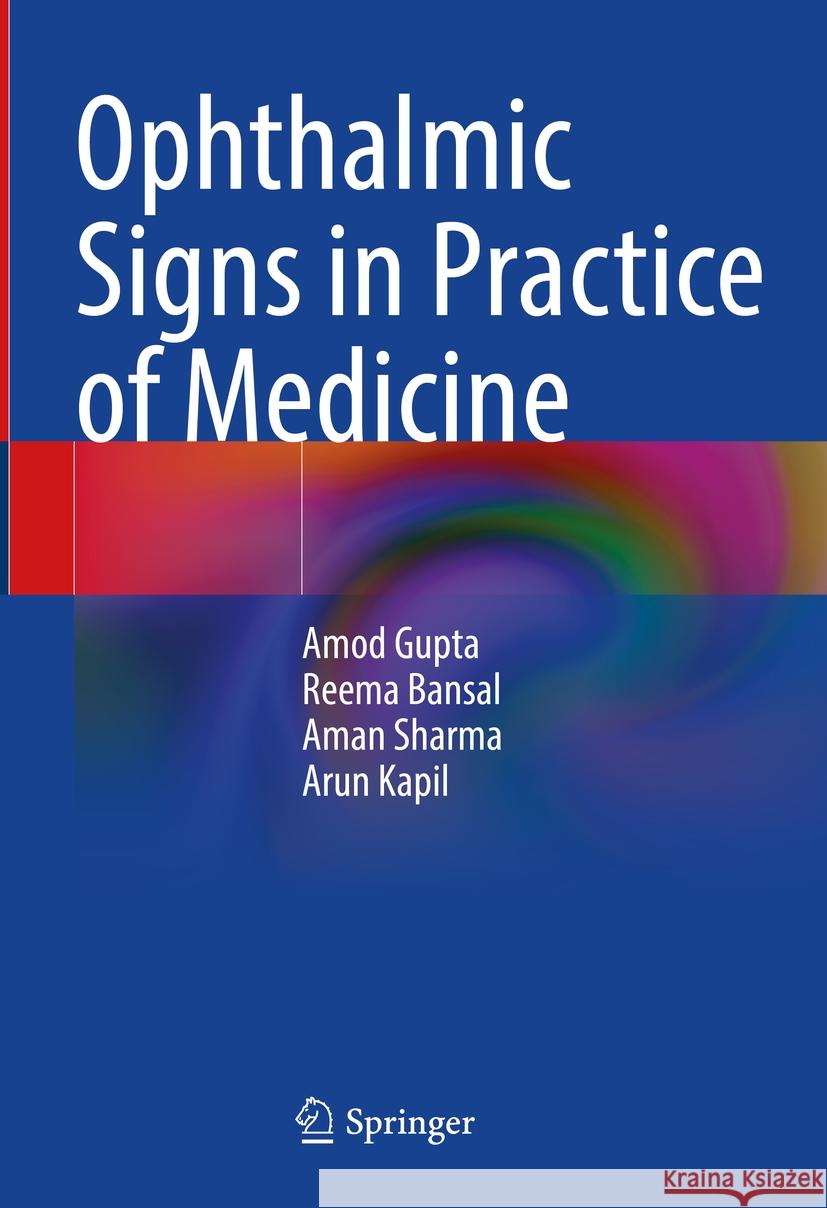Ophthalmic Signs in Practice of Medicine » książka



Ophthalmic Signs in Practice of Medicine
ISBN-13: 9789819979226 / Angielski
Ophthalmic Signs in Practice of Medicine
ISBN-13: 9789819979226 / Angielski
(netto: 460,04 VAT: 5%)
Najniższa cena z 30 dni: 462,63
ok. 22 dni roboczych
Dostawa w 2026 r.
Darmowa dostawa!
Dr Amod Gupta graduated from Medical College, Rohtak (Haryana, India) in 1973 and earned his master of surgery (ophthalmology) from Post Graduate Institute of Medical Education and Research (PGIMER), Chandigarh, India in 1976. He joined the faculty of PGIMER, Chandigarh in 1980 and remained chairman of the department of ophthalmology, from 1989 till 2015 and founded the Advanced Eye Centre in 2006. He is currently an emeritus professor. He has published more than 400 research papers, made several path-breaking discoveries in clinical ophthalmology and is one of the most cited ophthalmologists in India. He has presented innumerable papers, posters, invited lectures, named lectures and orations. He has been a former president of the Vitreo-retinal Society of India and was the founder president of the Uveitis Society of India. He has received more than 40 national and international awards, including the most coveted Padma Shri, the 4th highest civilian award from the President of India.
Dr Reema Bansal graduated from Medical College, M.S. University, Baroda (Gujarat, India) in 1996 and earned her MS (ophthalmology) in 2000. She joined the Post Graduate Institute of Medical Education and Research (PGIMER), Chandigarh, India in the year 2002 as a research fellow and was inducted into the faculty of the Advanced Eye Centre in the year 2011 and became a professor in 2021. She earned her PhD from the PGIMER in the year 2020. She has contributed more than 150 research papers and 26 book chapters. Her research has fetched her several awards for best papers and posters including at least 3 appreciation awards for publishing the best paper of the year at the PGIMER. She is a member of several societies including the prestigious International Uveitis Study Group. She is a reviewer for several peer reviewed journals.
Dr Aman Sharma graduated from Medical College Amritsar, India in 1998 and earned his MD in 2001. He was inducted into the faculty of internal medicine at the Post Graduate Institute of Medical Education and Research (PGIMER), Chandigarh, India in 2005 and became a professor of clinical immunology and rheumatology in 2017. He initiated a post-doctoral, Doctor of Medicine (DM) course in clinical immunology and rheumatology in 2014. He is the program director, Centre of Excellence in HIV/AIDS. He has published nearly 450 research papers and more than 100 meeting abstracts and 52 book chapters. He has delivered more than 190 invited lectures and conducted courses and workshops. He has also guided more than 50 MD, DM, and PhD theses besides being a PI or co-PI in more than 20 clinical and drug trials. Recipient of several named awards and lectures, he is selected as the editor in chief of the Indian Journal of Rheumatology.
Mr. Arun Kapil is a senior ophthalmic technician, in-charge of the Digital Retina Imaging Laboratory at the Advanced Eye Centre, PGIMER Chandigarh, India. In his career spanning four decades, he has performed imaging on nearly 300,000 patients. He is an expert in retinal imaging like color fundus photography, fundus fluorescein angiography and optical coherence tomography and OCTA. He has been certified by Bern photographic reading center, EyeKor Inc., DARC, UW-FPRC and others for several clinical trials. Hundreds of his illustrations have been published in journals like NEJM, JAMA Ophthalmology, etc. and several books. He has trained several ophthalmic technicians from across India for ophthalmic photography. He has been a recipient of several awards.
The book provides basic knowledge of clinical ophthalmic signs and their application in the clinical practice of medicine. It discusses several intra and extraocular signs that help the ophthalmologists to reach a diagnosis and suggest the presence or absence of an underlying severe sight-threatening or even life-threatening disease, such as diabetes, hypertension, cardiovascular disease, hematological disorders, systemic vasculitis, rheumatological disorders, brain tumors, sarcoidosis, or infectious diseases caused by M. tuberculosis, HIV or herpes viruses.
The book is divided into two sections and each chapter is dedicated to one ophthalmic sign providing its pathophysiology, significance, differential diagnosis and clues to systemic disease. Each chapter is profusely illustrated with color and black and white images, and boxes with key messages on differential diagnosis and appropriate laboratory investigations.
This book serves as a one-stop resource discussing the significance of individual ophthalmic signs and their context to sensitize the physicians, both the graduates and postgraduates in training, residents and fellows in ophthalmology, family medicine and internal medicine, and practicing physicians.
1997-2025 DolnySlask.com Agencja Internetowa
KrainaKsiazek.PL - Księgarnia Internetowa









